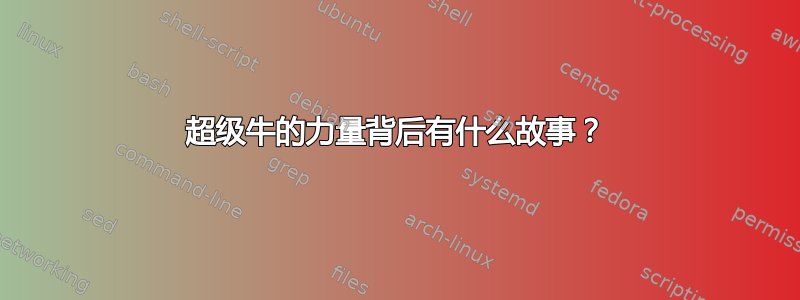
众所周知,apt-get拥有超级牛的力量但aptitude不:
$ apt-get --help | grep -i cow
This APT has Super Cow Powers.
$ aptitude --help | grep -i cow
This aptitude does not have Super Cow Powers.
当然,APT 还有一个彩蛋:
$ apt-get moo
(__)
(oo)
/------\/
/ | ||
* /\---/\
~~ ~~
...."Have you mooed today?"...
我很好奇,这个彩蛋背后有什么故事吗?它的历史是什么?我知道它已经在 apt 中存在了很长一段时间——通过快速 grep 旧 Debian 版本中的 apt 源代码,它在 Debian 2.2(potato;apt 0.3.19)和 Debian 3.0(woody;apt 0.5.4)之间的某个时间获得了它。
编辑:根据一个雅各布·昆茨的消息在 Debian-Devel 邮件列表中,它是 2001 年 2 月的 apt 0.5.0。马特·齐默尔曼的消息Debian bug 跟踪器上的 0.5.0 听起来像是它被添加时的样子。
答案1
Apt 于 1997 年左右诞生,并于 1999 年左右正式进入 Debian。在其早期,Jason Gunthorpe 是其主要维护者/开发者。嗯,显然杰森喜欢牛。我不知道他现在是否还这样。 :-) 无论如何,我认为这apt-get moo件事是他作为一个笑话添加的。我认为,丹尼尔·伯罗斯后来添加了相应的aptitude复活节彩蛋(见下文)作为致敬。
如果故事还有更多内容,杰森可能就是要问的人。他(可能是为了回答这个问题)写了Google+ 上的帖子。其中一小部分:
很久以前,一位开发人员因在 IRC 上用简单明了的“Moo”来宣布自己的存在而闻名。就像牧场上的牛一样,其他人也会经常回敬问候。这导致了一系列基于牛的笑话。
还:
$ aptitude moo
There are no Easter Eggs in this program.
$ aptitude -v moo
There really are no Easter Eggs in this program.
$ aptitude -vv moo
Didn't I already tell you that there are no Easter Eggs in this program?
$ aptitude -vvv moo
Stop it!
$ aptitude -vvvv moo
Okay, okay, if I give you an Easter Egg, will you go away?
$ aptitude -vvvvv moo
All right, you win.
/----\
-------/ \
/ \
/ |
-----------------/ --------\
----------------------------------------------
$ aptitude -vvvvvv moo
What is it? It's an elephant being eaten by a snake, of course.
答案2
我一直认为这个功能源自cowsay& cowthink。请参阅维基百科关于 Cowsay 的文章。我多年来一直在 Fedora 上使用这些(我相信它们早于 1999 年),并被用来以更有趣的方式显示财富。
$ fortune | cowsay
________________________________________
/ It doesn't matter what you do, it only \
| matters what you say you've done and |
\ what you're going to do. /
----------------------------------------
\ ^__^
\ (oo)\_______
(__)\ )\/\
||----w |
|| ||
您还可以使用其中任何一个来传递您自己的字符串:
$ cowthink 'I love Fedora, Debian? Not so much!'
_____________________________________
( I love Fedora, Debian? Not so much! )
-------------------------------------
o ^__^
o (oo)\_______
(__)\ )\/\
||----w |
|| ||
它还包括使用备用文件的能力.cow,这样您就可以交换其他文件来代替牛,例如燕尾服。
$ cowthink -f tux 'mmmmm....Fedora!'
__________________
( mmmmm....Fedora! )
------------------
o
o
.--.
|o_o |
|:_/ |
// \ \
(| | )
/'\_ _/`\
\___)=(___/
答案3
我相信这与“前http”时代相比已经有很长的路要走。要么是 Usenet,要么是 BBS。也许早在 1987 年左右?...
我记得在 Usenet 的早期有大量的 ASCII 艺术在流传。 IIRC 其中一个帖子开始以一头牛为特色,然后其他一些帖子以更多奶牛为特色,然后一个帖子完全致力于几头奶牛的 ascii-arts。我相信这个复活节彩蛋来自当时阅读这些内容的人......
我做了几次搜索,发现了一个地质城市页面正在谈论它。该页面指出(摘录:)
Besides digrams and charts, probably the earliest ASCII art from the Internet
are the "Spy at the Wall" collection and the "Silly Cows" collection.
David Bader, an ASCII art enthusiast and editor of the 'Cows", recently sent
me the COMPLETE, UNCUT, ORIGINAL, and OFFICIAL Silly Cow collection!
These cows can be seen all over the Internet and are truly considered to be
"classic" ASCII art..
“傻牛”链接到:http://www.geocities.com/spunk1111/cows.htm(也可以在互联网 Wayback Machine 上找到:https://web.archive.org/web/20131225210911/http://www.geocities.com/spunk1111/cows.htm,或者更确切地说去https://web.archive.org/web/*/http://www.geocities.com/spunk1111/cows.htm然后在您想查看快照当天的下面的议程中单击...)
当然,真正的参考资料在于 usenet 档案,但我还没有太多时间进行适当的研究(我可能会在不久的将来更新这篇文章)
在某个时候,甚至alt.cows.moo.moo.moo创建了一个新闻组(可能是在奶牛开始入侵 ascii 艺术之后很久?但也许之前,我没有时间进行适当的研究)(例如参见:http://www.418-teapot.com/topics/usenet/)
为了证明它在 Usenet 中有多受欢迎,互联网 Oracle 维基百科页面上提到的第一个问题是:http://en.wikipedia.org/wiki/Internet_Oracle是关于牛的。
答案4
嗯,我一直认为(也许是错误的,它们都源于同一来源)它与当时非常流行的 RC5 挑战赛有关,该挑战赛涉及 Distributed.net 的客户端:http://www.distributed.net/RC5巧合的是,这也是在 1997 年……


